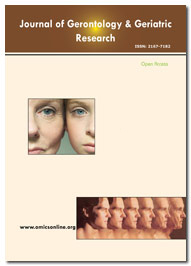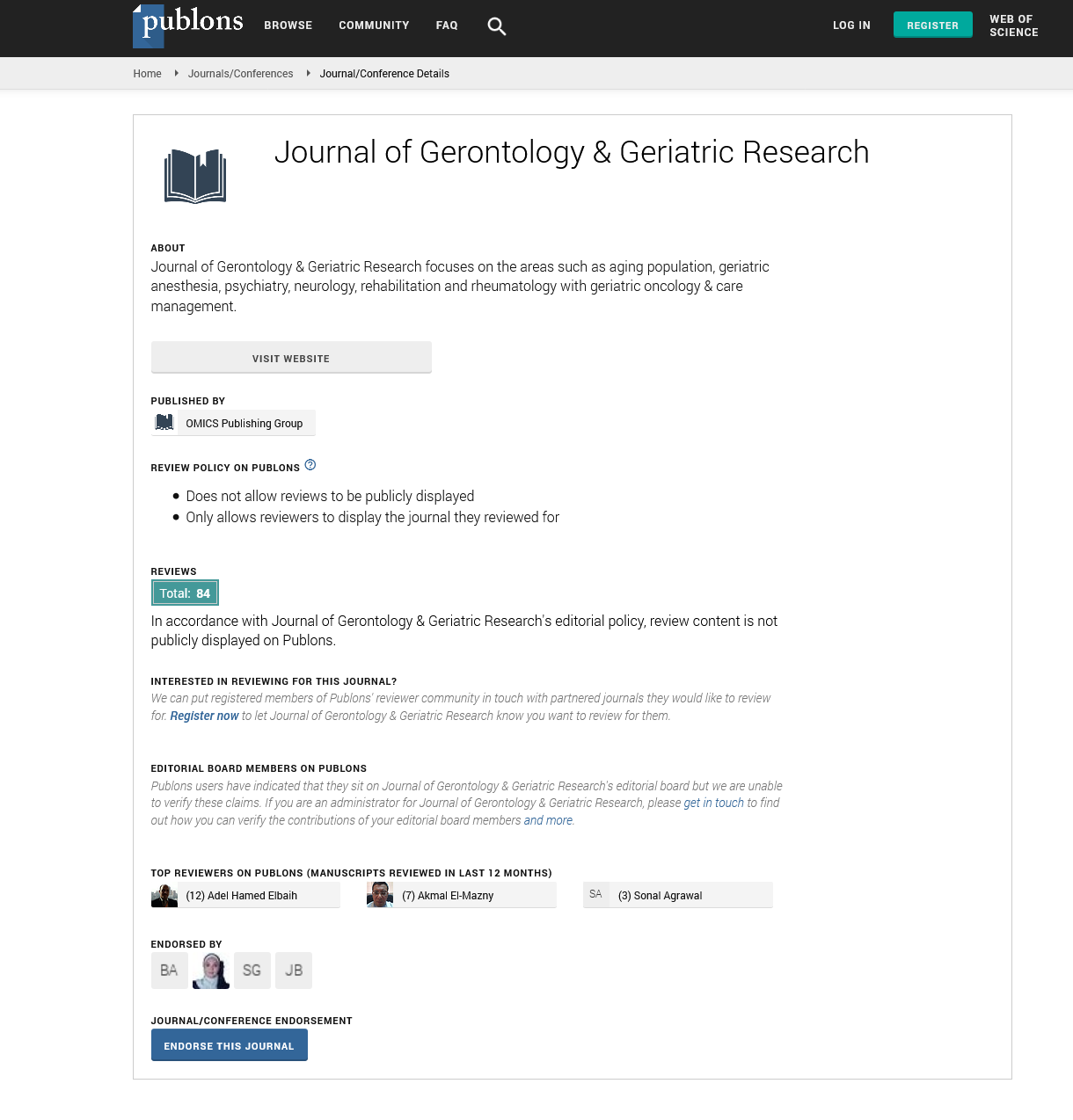Indexed In
- Open J Gate
- Genamics JournalSeek
- SafetyLit
- RefSeek
- Hamdard University
- EBSCO A-Z
- OCLC- WorldCat
- Publons
- Geneva Foundation for Medical Education and Research
- Euro Pub
- Google Scholar
Useful Links
Share This Page
Journal Flyer

Open Access Journals
- Agri and Aquaculture
- Biochemistry
- Bioinformatics & Systems Biology
- Business & Management
- Chemistry
- Clinical Sciences
- Engineering
- Food & Nutrition
- General Science
- Genetics & Molecular Biology
- Immunology & Microbiology
- Medical Sciences
- Neuroscience & Psychology
- Nursing & Health Care
- Pharmaceutical Sciences
Opinion - (2024) Volume 13, Issue 5
The Intersection of Multimorbidity and Polypharmacy in Elderly Populations
Kim Zhyo*Received: 02-Oct-2024, Manuscript No. jggr-24-27670; Editor assigned: 04-Oct-2024, Pre QC No. P-27670; Reviewed: 17-Oct-2024, QC No. Q-27670; Revised: 23-Oct-2024, Manuscript No. R-27670; Published: 30-Oct-2024, DOI: 10.35248/2167-7182.2024.13.760
Introduction
The global aging population is rapidly increasing, with more individuals living longer lives than ever before. As life expectancy rises, so too does the prevalence of chronic health conditions, leading to a surge in multimorbidity— the co-occurrence of multiple chronic diseases in the same individual. This is particularly true in elderly populations, where the risk of developing multiple health issues such as hypertension, diabetes, arthritis, and cardiovascular disease becomes more pronounced. The management of these conditions often requires complex medical regimens involving multiple medications, a phenomenon known as polypharmacy. Polypharmacy, typically defined as the use of five or more medications, has become a common practice in treating elderly individuals with multimorbidity [1]. While polypharmacy is intended to improve health outcomes, it is not without its risks, especially in older adults who are more vulnerable to adverse drug reactions, drug interactions, and medication non-adherence due to age-related physiological changes. This article will explore the intersection of multimorbidity and polypharmacy in elderly populations, examining how these factors interact, their implications for patient care, and the broader healthcare system. Furthermore, it will consider strategies for optimizing care to minimize risks and improve the quality of life for older adults facing these challenges.
Description
Multimorbidity refers to the coexistence of two or more chronic diseases or health conditions in an individual, which is especially prevalent among older adults. As people age, their bodies experience a gradual decline in physiological functions, making them more susceptible to a range of diseases. Common examples of multimorbidity in elderly populations include the concurrent presence of diabetes, hypertension, osteoarthritis, and heart disease. The rising incidence of multimorbidity is a global trend, and it poses significant challenges to both individuals and healthcare providers. Managing multiple health conditions simultaneously requires coordinated care and careful treatment planning to avoid complications and improve overall well-being. Polypharmacy, on the other hand, is the use of multiple medications, typically five or more, by an individual. For elderly patients with multimorbidity, polypharmacy is often a necessary part of their treatment regimen to manage their various conditions. However, polypharmacy carries its own set of risks. Older adults are more vulnerable to side effects and drug interactions due to age-related changes in metabolism, liver and kidney function, and organ sensitivity [2]. These factors can result in harmful adverse drug events, complicate treatment regimens, and negatively impact the patient's quality of life. Therefore, the relationship between multimorbidity and polypharmacy is complex and warrants careful consideration by healthcare providers.
There is an inherent link between multimorbidity and polypharmacy in elderly individuals. The presence of multiple chronic conditions necessitates the use of various medications to manage symptoms and prevent complications. For instance, an older adult with hypertension, diabetes, and chronic pain from osteoarthritis may be prescribed antihypertensive drugs, insulin, and analgesics, among other medications. As the number of conditions increases, so does the likelihood of polypharmacy. However, while polypharmacy is a common solution for managing multiple conditions, it presents significant challenges. The elderly are particularly susceptible to medication-related problems due to physiological changes associated with aging. These changes include slower drug metabolism, altered drug absorption, and a decrease in renal and hepatic clearance. Consequently, drugs that may be safe in younger populations can become dangerous for older adults, leading to an increased risk of adverse drug reactions, toxicity, or drug-drug interactions.
The health implications of multimorbidity and polypharmacy in older adults are profound and multifaceted. One of the most pressing concerns is the risk of medication-related harm, which includes adverse drug reactions, overdoses, and drug interactions. The elderly are more likely to experience these issues because of their altered pharmacokinetics and pharmacodynamics, making them more sensitive to medications and more prone to experiencing side effects. For example, medications that affect the central nervous system, such as sedatives and antidepressants, can increase the risk of falls, fractures, and cognitive impairment in elderly patients. In addition, polypharmacy can lead to medication non-adherence, which occurs when patients fail to follow prescribed regimens due to confusion over complicated medication schedules, side effects, or financial constraints [3].
Non-adherence is a significant issue, as it can lead to poor disease control, hospitalization, and even premature mortality. Research shows that elderly patients with multiple chronic conditions and complex medication regimens are particularly vulnerable to this problem. Another critical concern is clinical inertia, where healthcare providers continue to prescribe medications without regularly evaluating their appropriateness, especially when patients are on long-term treatment for multiple conditions. This inertia can result in the continuation of ineffective, unnecessary, or even harmful drugs, which may have been prescribed years ago without reconsidering their current relevance. Furthermore, fragmented care, characterized by a lack of communication between various specialists, can increase the risk of medication errors, duplication of therapies, and interactions between drugs that might not be immediately apparent to a single healthcare provider.
To manage the intersection of multimorbidity and polypharmacy in elderly populations, several strategies must be adopted. One of the most effective approaches is comprehensive medication reviews, where healthcare providers, especially pharmacists, systematically assess the patient’s medication regimen. This review aims to identify potentially inappropriate medications, recognize adverse drug interactions, and eliminate unnecessary drugs. Regular medication reviews are essential for ensuring that the elderly patient’s treatment remains appropriate and that any potential risks associated with polypharmacy are minimized. Another key strategy is deprescribing, the process of tapering or discontinuing medications that are no longer necessary or are causing harm. Deprescribing can help reduce the medication burden on elderly individuals, minimizing the risk of adverse effects and improving medication adherence. However, deprescribing should be carried out carefully, with patient involvement in the decision-making process, and under the guidance of healthcare professionals [4].
Incorporating patient-centered care is also critical in addressing multimorbidity and polypharmacy. By involving older adults in decisions about their care, healthcare providers can ensure that treatment plans align with patients' preferences, values, and life goals. Patient-centered care emphasizes the importance of considering the whole person, not just their diseases, which can lead to better outcomes and a more satisfying healthcare experience. Additionally, improving care coordination is essential. Healthcare providers, including primary care physicians, specialists, and pharmacists, must collaborate and communicate regularly to ensure that all aspects of the patient’s health are being addressed in a cohesive manner [5]. This can help prevent medication duplication, reduce unnecessary treatments, and improve overall care. Finally, personalized medicine is becoming an increasingly important tool in managing multimorbidity in older adults. By tailoring treatment plans to the individual’s specific genetic profile, lifestyle, and comorbid conditions, healthcare providers can offer more targeted therapies that are more likely to be effective and cause fewer side effects.
Conclusion
The intersection of multimorbidity and polypharmacy in elderly populations is a complex and pressing issue that demands attention from both healthcare providers and policymakers. As the elderly population continues to grow, managing the multiple chronic conditions commonly seen in older adults will become an even greater challenge. Polypharmacy, while necessary for many individuals with multimorbidity, presents significant risks due to the increased likelihood of adverse drug reactions, drug interactions, and medication non-adherence. However, with careful management and strategies such as comprehensive medication reviews, deprescribing, patient-centered care, and enhanced care coordination, the risks associated with polypharmacy can be mitigated. The healthcare system must recognize the unique needs of elderly individuals and prioritize integrated, holistic approaches to care. Training healthcare providers in the complexities of geriatric care, emphasizing preventative measures, and promoting a patient-centered approach will be crucial in improving the health outcomes of older adults.
Acknowledgement
None.
Conflict of Interest
None.
References
- Petersen RC, Bennett D. Mild cognitive impairment: Is it Alzheimer's disease or not? J Alzheimer Dis. 2005;7:241-245.
- Petersen RC. Mild cognitive impairment. N Engl J Med. 2016;22:404-418.
- Tinetti ME. Performance-oriented assessment of mobility problems in the elderly. J Am Geriatr Soc. 1986;36:613-616.
- Park SH. Tools for assessing fall risk in the elderly: A systematic review and meta-analysis. Aging Clin Experim Res. 2018;30:1-6.
- Zarulli V, Sopina E, Toffolutti V, Lenart A. Health care system efficiency and life expectancy: A 140-country study. PLoS One. 2021;16:e0253450.
Google Scholar, Crossref, Indexed at
Google Scholar, Crossref, Indexed at
Google Scholar, Crossref, Indexed at
Google Scholar, Crossref, Indexed at
Citation: Zhyo K (2024). The Intersection of Multimorbidity and Polypharmacy in Elderly Populations. J Gerontol Geriatr Res. 13: 760.
Copyright: © 2024 Zhyo K. This is an open-access article distributed under the terms of the Creative Commons Attribution License, which permits unrestricted use, distribution, and reproduction in any medium, provided the original author and source are credited.

